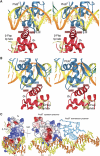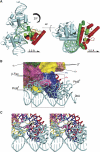The structure of a transcription activation subcomplex reveals how σ(70) is recruited to PhoB promoters
- PMID: 21829166
- PMCID: PMC3173795
- DOI: 10.1038/emboj.2011.271
The structure of a transcription activation subcomplex reveals how σ(70) is recruited to PhoB promoters
Abstract
PhoB is a two-component response regulator that activates transcription by interacting with the σ(70) subunit of the E. coli RNA polymerase in promoters in which the -35 σ(70)-recognition element is replaced by the pho box. The crystal structure of a transcription initiation subcomplex that includes the σ(4) domain of σ(70) fused with the RNA polymerase β subunit flap tip helix, the PhoB effector domain and the pho box DNA reveals how σ(4) recognizes the upstream pho box repeat. As with the -35 element, σ(4) achieves this recognition through the N-terminal portion of its DNA recognition helix, but contact with the DNA major groove is less extensive. Unexpectedly, the same recognition helix contacts the transactivation loop and helices α2 and α3 of PhoB. This result shows a simple and elegant mechanism for polymerase recruitment to pho box promoters in which the lost -35 element contacts are compensated by new ones with the activator. In addition, σ(4) is reoriented, thereby suggesting a remodelling mechanism for transcription initiation.
Conflict of interest statement
The authors declare that they have no conflict of interest.
Figures






Similar articles
-
σ70 and PhoB activator: getting a better grip.Transcription. 2012 Jul-Aug;3(4):160-4. doi: 10.4161/trns.20444. Epub 2012 Jul 1. Transcription. 2012. PMID: 22771992 Free PMC article. Review.
-
Role of the sigma 70 subunit of RNA polymerase in transcriptional activation by activator protein PhoB in Escherichia coli.Genes Dev. 1993 Jan;7(1):149-60. doi: 10.1101/gad.7.1.149. Genes Dev. 1993. PMID: 8422984
-
Structural basis for -35 element recognition by σ4 chimera proteins and their interactions with PmrA response regulator.Proteins. 2020 Jan;88(1):69-81. doi: 10.1002/prot.25768. Epub 2019 Jul 22. Proteins. 2020. PMID: 31293000
-
Mutational analysis of the role of the first helix of region 4.2 of the sigma 70 subunit of Escherichia coli RNA polymerase in transcriptional activation by activator protein PhoB.Mol Gen Genet. 1995 Jul 22;248(1):1-8. doi: 10.1007/BF02456607. Mol Gen Genet. 1995. PMID: 7651320
-
Identification of a prime suspect.Curr Biol. 1997 Feb 1;7(2):R97-9. doi: 10.1016/s0960-9822(06)00047-9. Curr Biol. 1997. PMID: 9081674 Review.
Cited by
-
Crystallization and preliminary X-ray diffraction analysis of the DNA-binding domain of the response regulator SaeR from Staphylococcus epidermidis.Acta Crystallogr Sect F Struct Biol Cryst Commun. 2013 Jun;69(Pt 6):689-91. doi: 10.1107/S1744309113012943. Epub 2013 May 25. Acta Crystallogr Sect F Struct Biol Cryst Commun. 2013. PMID: 23722855 Free PMC article.
-
The CopRS two-component system is responsible for resistance to copper in the cyanobacterium Synechocystis sp. PCC 6803.Plant Physiol. 2012 Aug;159(4):1806-18. doi: 10.1104/pp.112.200659. Epub 2012 Jun 19. Plant Physiol. 2012. PMID: 22715108 Free PMC article.
-
Structural biology of bacterial RNA polymerase.Biomolecules. 2015 May 11;5(2):848-64. doi: 10.3390/biom5020848. Biomolecules. 2015. PMID: 25970587 Free PMC article. Review.
-
X-ray crystal structure of Escherichia coli RNA polymerase σ70 holoenzyme.J Biol Chem. 2013 Mar 29;288(13):9126-34. doi: 10.1074/jbc.M112.430900. Epub 2013 Feb 6. J Biol Chem. 2013. PMID: 23389035 Free PMC article.
-
Fine-tuning control of phoBR expression in Vibrio cholerae by binding of phoB to multiple pho boxes.J Bacteriol. 2011 Dec;193(24):6929-38. doi: 10.1128/JB.06015-11. Epub 2011 Oct 7. J Bacteriol. 2011. PMID: 21984792 Free PMC article.
References
-
- Abrahams JP, Leslie AG (1996) Methods used in the structure determination of bovine mitochondrial F1 ATPase. Acta Crystallogr D Biol Crystallogr 52: 30–42 - PubMed
-
- Benoff B, Yang H, Lawson CL, Parkinson G, Liu J, Blatter E, Ebright YW, Berman HM, Ebright RH (2002) Structural basis of transcription activation: the CAP-alpha CTD-DNA complex. Science 297: 1562–1566 - PubMed
-
- Blanco AG, Solà M, Gomis-Rüth FX, Coll M (2002) Tandem DNA recognition by PhoB, a two-component signal transduction transcriptional activator. Structure 10: 701–713 - PubMed
-
- Brünger AT, Adams PD, Clore GM, DeLano WL, Gros P, Grosse-Kunstleve RW, Jiang J-S, Kuszewski J, Nilges M, Pannu NS, Read RJ, Rice LM, Simonson T, Warren GL (1998) Crystallography & NMR System: a new software suite for macromolecular structure determination. Acta Crystallogr D Biol Crystallogr 54: 905–921 - PubMed
-
- Burgess RR (1969) Separation and characterization of the subunits of ribonucleic acid polymerase. J Biol Chem 244: 6168–6176 - PubMed
Publication types
MeSH terms
Substances
LinkOut - more resources
Full Text Sources
Other Literature Sources
Molecular Biology Databases
Research Materials

